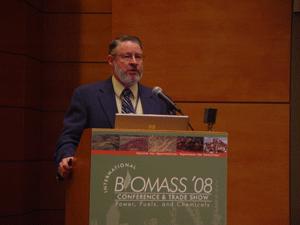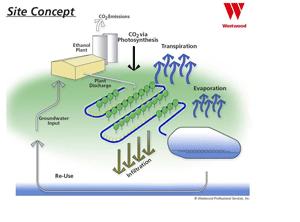BIOMASS 08: Ethanol plants explore water recycling options







January 1, 1970
BY Jessica Sobolik
Web exclusive posted April 23, 2008 at 12:54 p.m. CST
Since ethanol plants typically take in approximately three gallons of water to produce one gallon of ethanol, water usage is an issue. Two unnamed plants in particular are exploring separate water recycling programs, which were presented at the International Biomass Conference & Trade Show on April 17 in Minneapolis.
Marcus Allhands, vice president of Orival Inc., detailed an ethanol case study that his company conducted with a 110 MMgy ethanol plant in Iowa that chose to reuse effluent from a wastewater treatment plant six miles away. The facility, which uses approximately 330 MMgy of process water, installed a pipeline connecting the two businesses. After exploring different options, plant management decided to install three auto screen filters supplied by Orival. The filters screen solid particles from the effluent as it comes into the plant. Each screen monitors the change in water pressure as solid particles are collected, and when the water pressure reaches a certain level, the filter automatically rinses the screen for 10 seconds using 14 gallons of water per unit. This is done without taking the plant offline for maintenance.
Initially, when the filters were installed and the water was turned on, the filters became clogged, Allhands said. Later, construction debris in the pipeline was found to be the culprit. The pipes were flushed, and no problems occurred after that. The units have been in continuous operation for more than a year.
Chad Grismer, an engineer with Westwood Professional Services Inc., presented a different water-recycling option that a Minnesota ethanol plant was considering before the industry's economics took a downturn. "That project is now in a holding pattern," Grismer said. This option allows a plant to reuse discharge water as non-process water, reducing groundwater consumption and recharging groundwater supplies. This can be achieved through an evapotranspiration channel that would wind back and forth outside the ethanol plant, passing through an area of planted trees before the water enters a nearby pond. The trees would take in the water, including the dissolved particles within the water, and transpire it into the atmosphere, along with evaporation. The trees could double as a biomass resource. The plant could then take the water from the pond and re-insert it into the plant.
Since ethanol plants typically take in approximately three gallons of water to produce one gallon of ethanol, water usage is an issue. Two unnamed plants in particular are exploring separate water recycling programs, which were presented at the International Biomass Conference & Trade Show on April 17 in Minneapolis.
Marcus Allhands, vice president of Orival Inc., detailed an ethanol case study that his company conducted with a 110 MMgy ethanol plant in Iowa that chose to reuse effluent from a wastewater treatment plant six miles away. The facility, which uses approximately 330 MMgy of process water, installed a pipeline connecting the two businesses. After exploring different options, plant management decided to install three auto screen filters supplied by Orival. The filters screen solid particles from the effluent as it comes into the plant. Each screen monitors the change in water pressure as solid particles are collected, and when the water pressure reaches a certain level, the filter automatically rinses the screen for 10 seconds using 14 gallons of water per unit. This is done without taking the plant offline for maintenance.
Initially, when the filters were installed and the water was turned on, the filters became clogged, Allhands said. Later, construction debris in the pipeline was found to be the culprit. The pipes were flushed, and no problems occurred after that. The units have been in continuous operation for more than a year.
Chad Grismer, an engineer with Westwood Professional Services Inc., presented a different water-recycling option that a Minnesota ethanol plant was considering before the industry's economics took a downturn. "That project is now in a holding pattern," Grismer said. This option allows a plant to reuse discharge water as non-process water, reducing groundwater consumption and recharging groundwater supplies. This can be achieved through an evapotranspiration channel that would wind back and forth outside the ethanol plant, passing through an area of planted trees before the water enters a nearby pond. The trees would take in the water, including the dissolved particles within the water, and transpire it into the atmosphere, along with evaporation. The trees could double as a biomass resource. The plant could then take the water from the pond and re-insert it into the plant.
Advertisement
Advertisement
Upcoming Events





